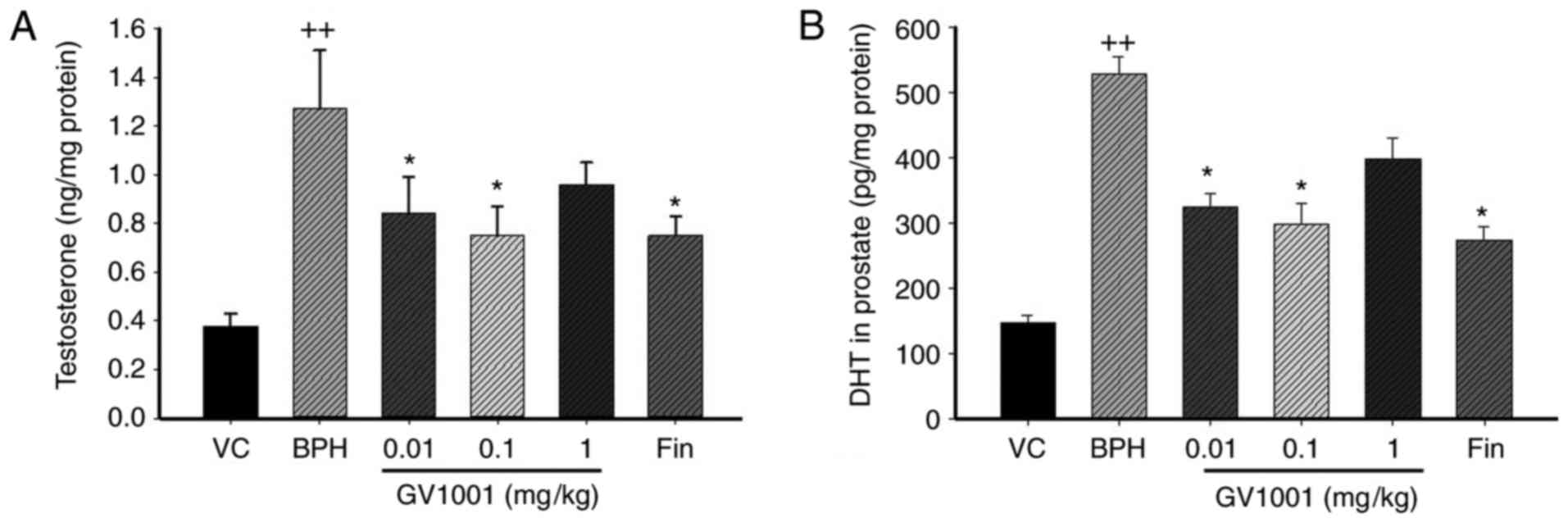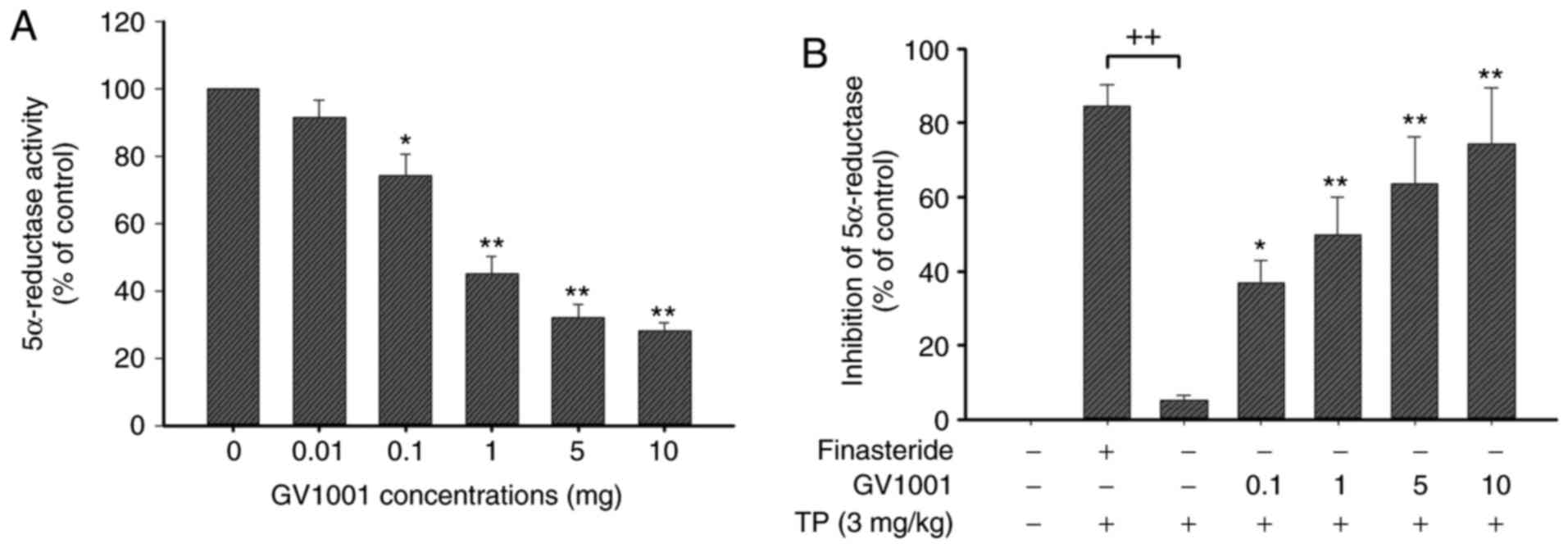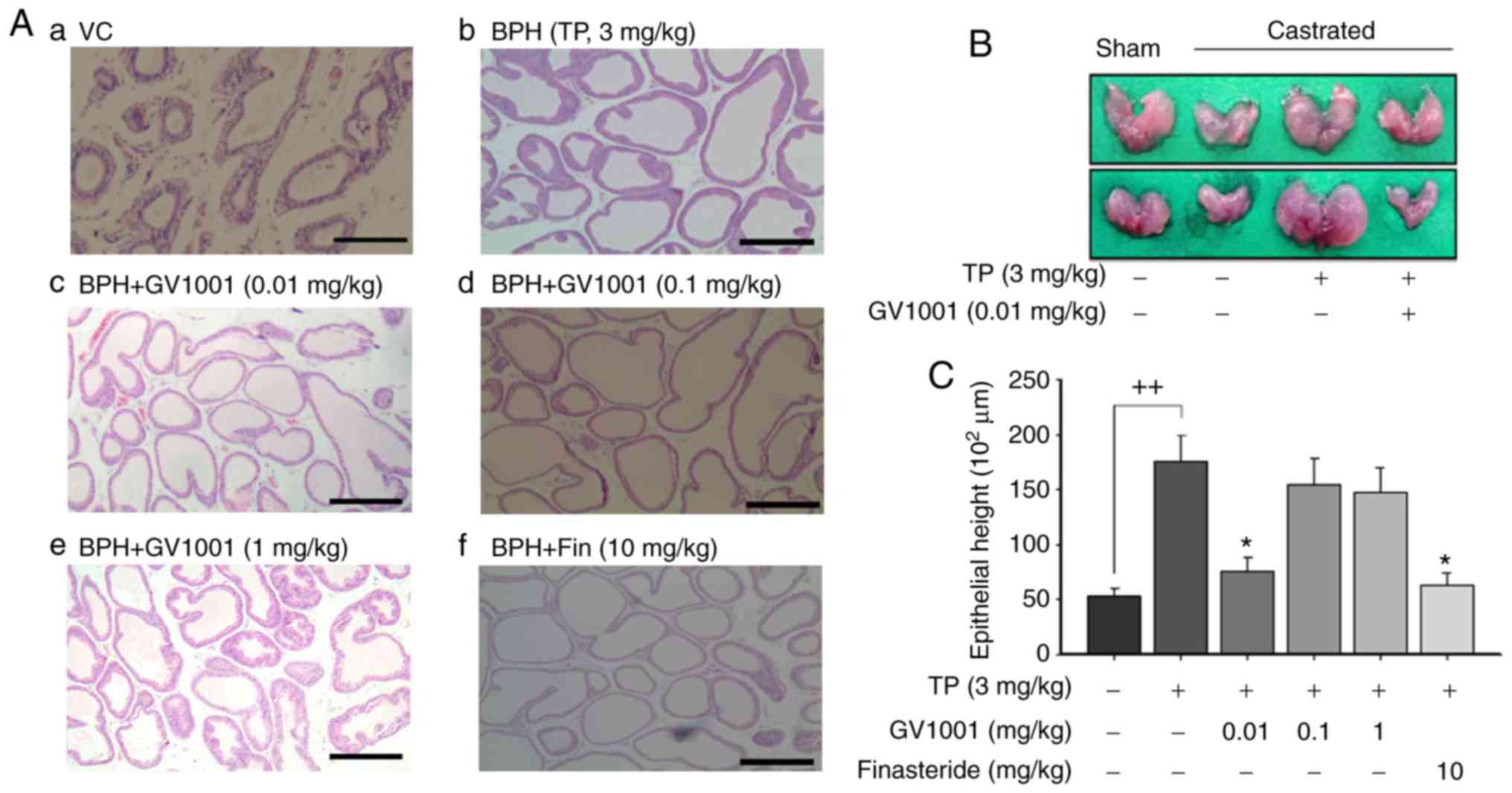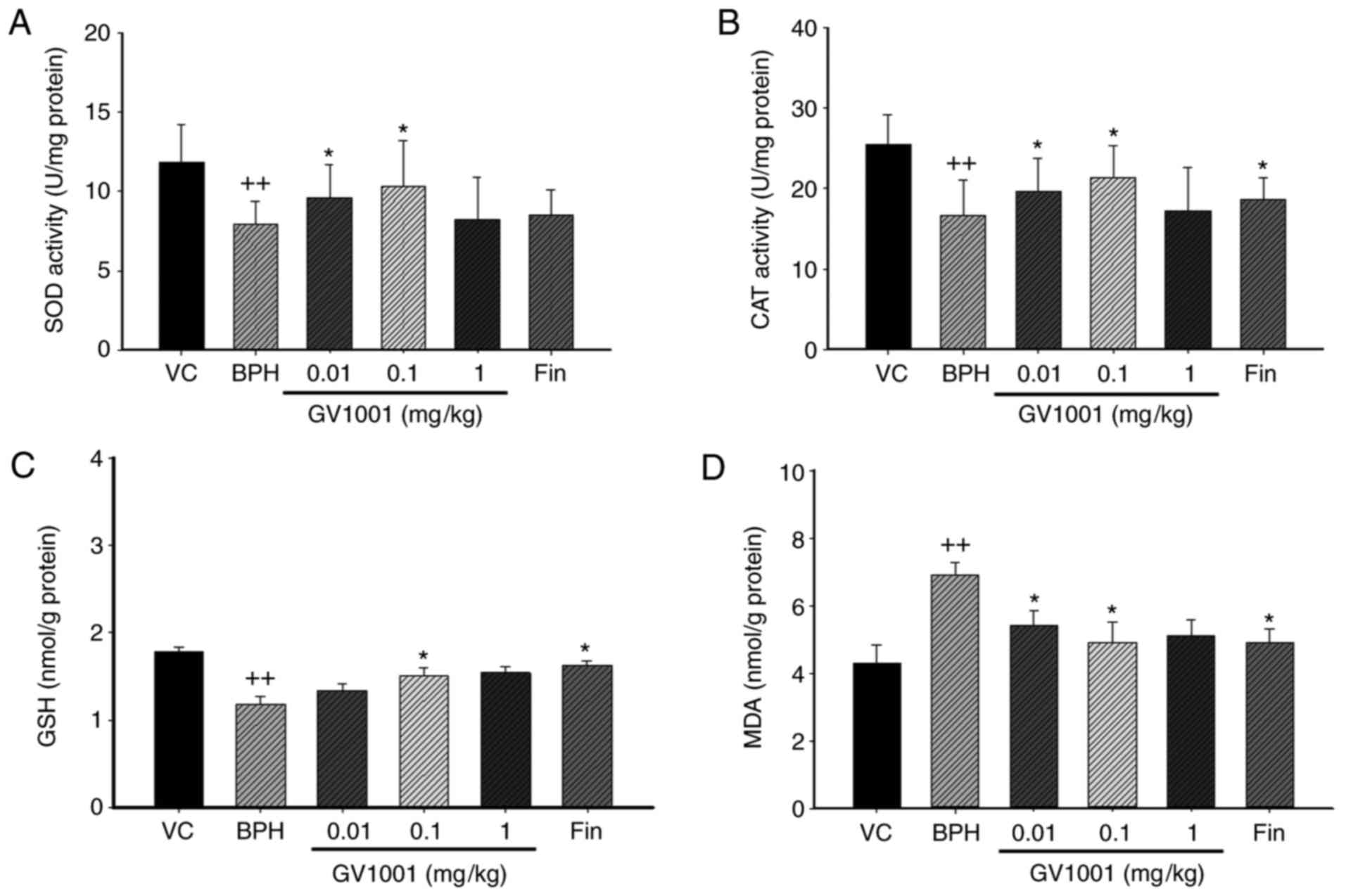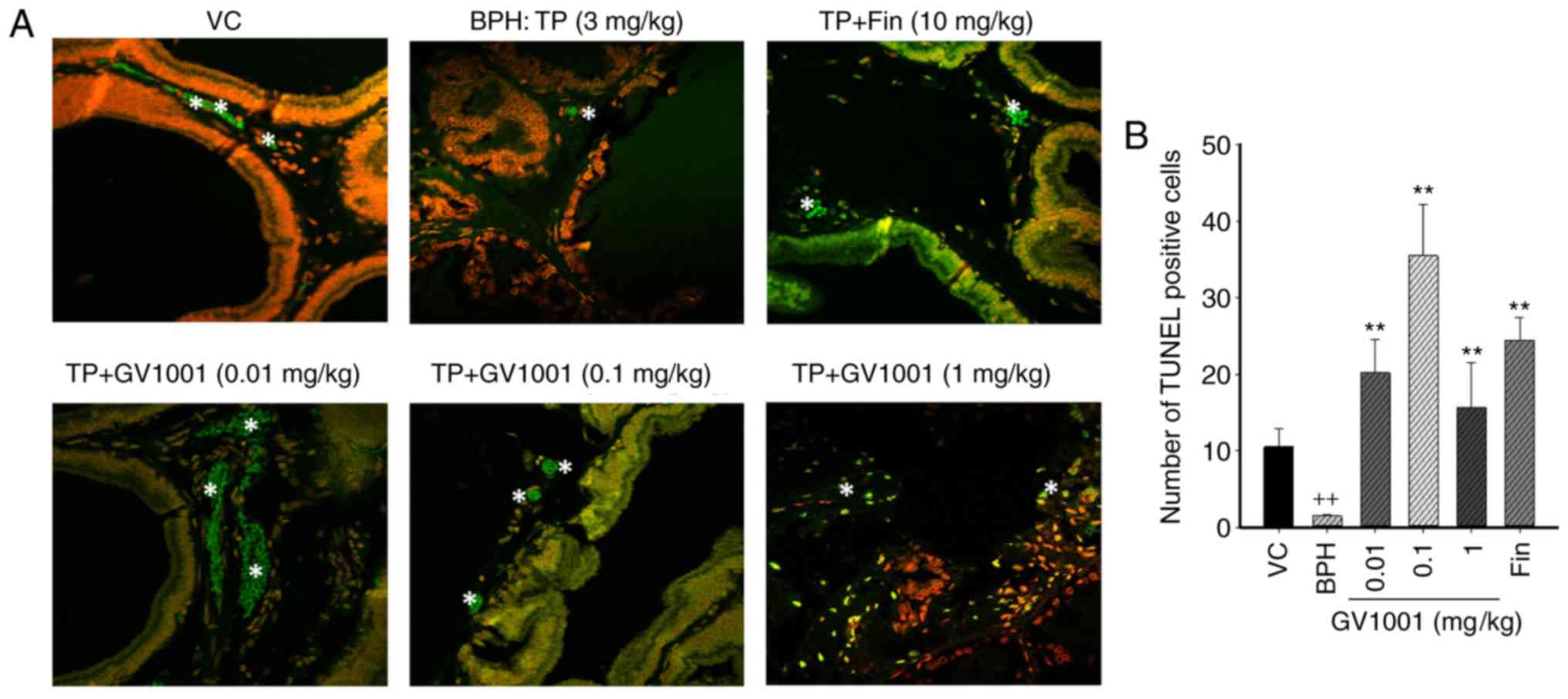|
1
|
Thorpe A and Neal D: Benign prostatic
hyperplasia. Lancet. 361:1359–1367. 2003. View Article : Google Scholar : PubMed/NCBI
|
|
2
|
Lee SWH, Chan EMC and Lai YK: The global
burden of lower urinary tract symptoms suggestive of benign
prostatic hyperplasia: A systematic review and meta-analysis. Sci
Rep. 7:79842017. View Article : Google Scholar : PubMed/NCBI
|
|
3
|
Lee YJ, lee JW, Park J, Seo SI, Chung JI,
Yoo TK and Son H: Nationwide incidence and treatment pattern of
benign prostatic hyperplasia in Korea. Investig Clin Urol.
57:424–430. 2016. View Article : Google Scholar : PubMed/NCBI
|
|
4
|
Henry G, Malewska A, Mauck R, Gahan J,
Hutchinson R, Torrealba J, Francis F, Roehrborn C and Strand D:
Molecular pathogenesis of human prostate basal cell hyperplasia.
Prostate. 77:1344–1355. 2017. View Article : Google Scholar : PubMed/NCBI
|
|
5
|
Chughtai B, Forde JC, Thomas DD, Laor L,
Hossack T, Woo HH, Te AE and Kaplan SA: Benign prostatic
hyperplasia. Nat Rev Dis Primers. 2:160312016. View Article : Google Scholar : PubMed/NCBI
|
|
6
|
Carson C III and Rittmaster R: The role of
dihydrotestosterone in benign prostatic hyperplasia. Urology. 61(4
Suppl 1): S2–S7. 2003. View Article : Google Scholar
|
|
7
|
Gandhi J, Weissbart SJ, Smith NL, Kaplan
SA, Dagur G, Zumbo A, Joshi G and Khan SA: The impact and
management of sexual dysfunction secondary to pharmacological
therapy of benign prostatic hyperplasia. Transl Androl Urol.
6:295–304. 2017. View Article : Google Scholar : PubMed/NCBI
|
|
8
|
Traish AM, Melcangi RC, Bortolato M,
Garcia-Segura LM and Zitzmann M: Adverse effects of 5α-reductase
inhibitors: What do we know, don't know, and need to know? Rev
Endocr Metab Disord. 16:177–198. 2015. View Article : Google Scholar : PubMed/NCBI
|
|
9
|
La Torre A, Giupponi G, Duffy D, Conca A,
Cai T and Scardigli A: Sexual dysfunction related to drugs: A
critical review. Part V: α-blocker and 5-ARI drugs.
Pharmacopsychiatry. 49:3–13. 2016.
|
|
10
|
Patel AK and Chappel CR: Benign prostatic
hyperplasia, treatment in primary health care. BMJ. 333:535–539.
2006. View Article : Google Scholar : PubMed/NCBI
|
|
11
|
Srivastava DS and Mittal RD: Free radical
injury and antioxidant status in patients with benign prostate
hyperplasia and prostate cancer. Indian J Clin Biochem. 20:162–165.
2005. View Article : Google Scholar : PubMed/NCBI
|
|
12
|
Minciullo PL, Inferrera A, Navarra M,
Calapai G, Magno C and Gangemi S: Oxidative stress in benign
prostatic hyperplasia: A systematic review. Urol Int. 94:249–254.
2015. View Article : Google Scholar
|
|
13
|
Jena AK, Vasisht K, Sharma N, Kaur R,
Dhingra MS and Karan M: Amelioration of testosterone induced benign
prostatic hyperplasia by Prunus species. J Ethnopharmacol.
190:33–45. 2016. View Article : Google Scholar : PubMed/NCBI
|
|
14
|
Prasad S, Kalra N and Shukla Y: Modulatory
effects of diallyl sulfide against testosterone induced oxidative
stress in Swiss albino mice. Asian J Androl. 8:719–723. 2006.
View Article : Google Scholar : PubMed/NCBI
|
|
15
|
Siddiquia IA, Raisuddin S and Shukla A:
Protective effects of black tea extract on testosterone induced
oxidative damage in prostate. Cancer Lett. 227:125–132. 2005.
View Article : Google Scholar
|
|
16
|
Parekh MH, Lobel R, Oconnor LJ, Legget RE
and Levin RM: Protective effect of vitamin E on the response of the
rabbit bladder to partial outlet obstruction. J Urol. 166:341–346.
2001. View Article : Google Scholar : PubMed/NCBI
|
|
17
|
Kyte JA: Cancer vaccination with
telomerase peptide GV1001. Expert Opin Investig Drugs. 18:687–694.
2009. View Article : Google Scholar : PubMed/NCBI
|
|
18
|
Shaw VE, Naisbitt DJ, Costello E,
Greenhalf W, Park BK, Neoptolemos JP and Middleton GW: Current
status of GV1001 and other telomerase vaccination strategies in the
treatment of cancer. Expert Rev Vaccines. 9:1007–1016. 2010.
View Article : Google Scholar : PubMed/NCBI
|
|
19
|
Bernhardt SL, Gjertsen MK, Trachsel S,
Møller M, Eriksen JA, Meo M, Buanes TG and Gaudernack G: Telomerase
peptide vaccination of patients with non-resectable pancreatic
cancer: A dose escalating phase I/II study. Br J Cancer.
95:1474–1482. 2006. View Article : Google Scholar : PubMed/NCBI
|
|
20
|
Middleton G, Ghaneh P, Costello E,
Greenhalf W and Neoptolemos JP: New treatment options for advanced
pancreatic cancer. Expert Rev Gastroenterol Hepatol. 2:673–696.
2008. View Article : Google Scholar : PubMed/NCBI
|
|
21
|
Hunger RE, Kernland Lang K, Markowski CJ,
Trachsel S, Møller M, Eriksen JA, Rasmussen AM, Braathen LR and
Gaudernack G: Vaccination of patients with cutaneous melanoma with
telomerase-specific peptides. Cancer Immunol Immunother.
60:1553–1564. 2011. View Article : Google Scholar : PubMed/NCBI
|
|
22
|
Brunsvig PF, Kyte JA, Kersten C, Sundstrøm
S, Møller M, Nyakas M, Hansen GL, Gaudernack G and Aamdal S:
Telomerase peptide vaccination in NSCLC: A phase II trial in stage
III patients vaccinated after chemoradiotherapy and an 8-year
update on a phase I/II trial. Clin Cancer Res. 17:6847–6857. 2011.
View Article : Google Scholar : PubMed/NCBI
|
|
23
|
Lee YK, Nata'atmaja BS, Kim BH, Pak CS and
Heo CY: Protective effect of telomerase-based 16-mer peptide
vaccine (gV1001) on inferior epigastric island skin flap
survivability in ischaemia-reperfusion injury rat model. J Plast
Surg Hand Surg. 51:210–216. 2017. View Article : Google Scholar
|
|
24
|
Park HH, Yu HJ, Kim S, Kim G, Choi NY, Lee
EH, Lee YJ, Yoon MY, Lee KY and Koh SH: Neural stem cells injured
by oxidative stress can be rejuvenated by GV1001, a novel peptide,
through scavenging free radicals and enhancing survival signals.
Neurotoxicology. 55:131–141. 2016. View Article : Google Scholar : PubMed/NCBI
|
|
25
|
Ko YJ, Kwon KY, Kum KY, Lee WC, Baek SH,
Kang MK and Shon WJ: The anti-inflammatory effect of human
telomerase-derived peptide on P. gingivalis
lipopolysaccharide-induced inflammatory cytokine production and its
mechanism in human dental pulp cells. Mediators Inflamm.
2015:3851272015. View Article : Google Scholar : PubMed/NCBI
|
|
26
|
Choi J, Kim H, Kim Y, Jang M, Jeon J,
Hwang YI, Shon WJ, Song YW, Kang JS, Lee WJ and Choi J: The
anti-inflammatory effect of GV1001 mediated by the downregulation
of eno1-induced pro-inflammatory cytokine production. Immune Netw.
15:291–303. 2015. View Article : Google Scholar
|
|
27
|
Lee MY, Shin IS, Seo CS, Lee NH, Ha HK,
Son JK and Shin HK: Effects of Melandrium firmum methanolic extract
on testosterone-induced benign prostatic hyperplasia in Wistar
rats. Asian J Androl. 14:320–324. 2012. View Article : Google Scholar : PubMed/NCBI
|
|
28
|
Steers WD: 5alpha-reductase activity in
the prostate. Urology. 58(6 Suppl 1): S17–S24. 2001. View Article : Google Scholar
|
|
29
|
Ali MI, Kondreddi HD and Veeresh B:
Protective effect of 2-hydroxy-4-methoxy benzoic acid on
testosterone induced benign prostatic hyperplasia in Wister rats.
Eur J Pharmacol. 698:397–403. 2013. View Article : Google Scholar
|
|
30
|
Aydin A, Arsova-Sarafinovska Z, Sayal A,
Eken A, Erdem O, Erten K, Ozgök Y and Dimovski A: Oxidative stress
and antioxidant status in non-metastatic prostate cancer and benign
prostatic hyperplasia. Clin Biochem. 39:176–179. 2006. View Article : Google Scholar : PubMed/NCBI
|
|
31
|
Sultan C, Paris F, Terouanne B, Balaguer
P, Georget V, Poujol N, Jeandel C, Lumbroso S and Nicolas JC:
Disorders linked to insufficient androgen action in male children.
Hum Reprod Update. 7:314–322. 2001. View Article : Google Scholar : PubMed/NCBI
|
|
32
|
Culig Z, Hobisch A, Cronauer MV, Radmayr
C, Hittmair A, Zhang J, Thurnher M, Bartsch G and Klocker H:
Regulation of prostatic growth and function by peptide growth
factors. Prostate. 28:392–405. 1996. View Article : Google Scholar : PubMed/NCBI
|
|
33
|
Jacobsen SJ, Girman CJ and Lieber MM:
Natural history of benign prostatic hyperplasia. Urology. 58(6
Suppl 1): S5–S16. 2001. View Article : Google Scholar
|
|
34
|
Bostanci Y, Kazzazi A, Momtahen S, Laze J
and Djavan B: Correlation between benign prostatic hyperplasia and
inflammation. Curr Opin Urol. 23:5–10. 2013. View Article : Google Scholar
|
|
35
|
Chung LW, Matsuura J and Runner MN: Tissue
interactions and prostatic growth. I Induction of adult mouse
prostatic hyperplasia by fetal urogenital sinus implants. Biol
Reprod. 31:155–163. 1984. View Article : Google Scholar : PubMed/NCBI
|
|
36
|
Vral A, Magri V, Montanari E, Gazzano G,
Gourvas V, Marras E and Perletti G: Topographic and quantitative
relationship between prostate inflammation, proliferative
inflammatory atrophy and low-grade prostate intraepithelial
neoplasia: A biopsy study in chronic prostatitis patients. Int J
Oncol. 41:1950–1958. 2012. View Article : Google Scholar : PubMed/NCBI
|
|
37
|
Gao M, Ding H, Zhong G, Lu J, Wang H, Li Q
and Wang Z: The effects of transrectal radiofrequency hyperthermia
on patients with chronic prostatitis and the changes of MDA, NO,
SOD, and Zn levels in pretreatment and posttreatment. Urology.
79:391–396. 2012. View Article : Google Scholar
|















